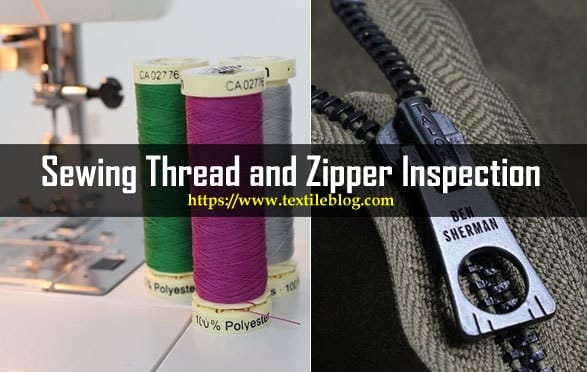Sewing Thread Inspection:
During sewing of garments, frequent breaking of thread, directly influences on the apparel production and its quality. It is important to mention here that in running condition of machine, the sewing threads run through the needles at a speed of 140 to 165 K.M per hour. Thread strength may be decreased from 2 to 32% due to the friction of sewing threads with the various parts of machines & fabrics. For that reason, before buying of sewing threads, the below mentioned properties of threads should be verified:

A. Thread Construction / Ticket Number:
The tests which should be done in order to be sure about the construction of thread, are as follows:
- Thread count
- Thread ply
- Number of twist
- Thread balance
- Thread tenacity
- Thread elongation
B. Sewability:
The sewing fitness of a thread is called its sewability. In order to determine the sewability, 3 packages of thread are taken from a lot, 100 yards of sewing is done and the running performance of the machine is listed. The main objective of this test is to know the capacity of flawless and beautiful sewing of each thread in a normal condition and at the highest speed of the sewing machine. During the test of sewability, the other properties of thread that should be examined are as follows:
1. Imperfections: If there is any knot or slub in the thread, the thread will break frequently, causing decreasing of both the efficiency and production of the machine and the quality of the produced goods will also be deteriorated.
You may also like: Sewing Thread Consumption Guide for Professional
2. Finish: The finish of thread is mainly meant to lubricant that helps thread to pass through needle eye and the various guides of machine. The amount of lubricant in threads may be from 3 to 15%. The amount of lubricant should be in the same percentage for each package of thread in a lot otherwise various problems will arise sewing.
3. The color of thread: Any color of thread including white, must match with its sample and the color of the thread in the same lot should not differ considerably. Otherwise, adverse effect may result on the quality of the garments.
4. The package density: Should not have any difference in density of a package or a cone from another cone. If there is difference in density, the efficiency and productivity of the machine will decrease due to frequent adjustment of the tension of the thread.
5. Winding: Thread should be properly wound in the package. Otherwise thread can break frequently during sewing due to the snarling of thread after coming out of the package. As a result, both the production and the quality of goods may be damaged.
6. Yardage: The length of thread in a package of thread has to be within 2% of the mentioned length (yardage) otherwise that package may be cancelled.
You may also like: Various Factors Influence Sewing Thread Consumption
Zipper Inspection:
Chain or zipper is a special part of a garment, which if defective, the garment may be unfit for wearing. Need to be ensured beforehand about the below issues so that the defects related to the zippers should not arise.
1. Dimension: Need to be ensured beforehand about the measurement of the length of the chain and the width of the tape so that it does not create any problem for shortage of dimension during attaching to the garments.
2. Stops: The stops ends at the upper end and the lower end of the chain must be stopped by sewing in garments properly, fairly and in well secured.
3. Uniform color: The color of the chain tape must be uniform.
4. Puckering: Need to be ensured so that no puckering in garments happen after attaching of the chain by sewing.
5. Dimension and color: After washing or dry cleaning or ironing, the dimension of the chain or its color should not be changed.
6. Slider: The movement of the slider through the chain should be easy but care should be taken so that the slider can be well locked in the chain.
7. Arrow mark: The chain should be attached in the garment as per the arrow mark in the slider.
